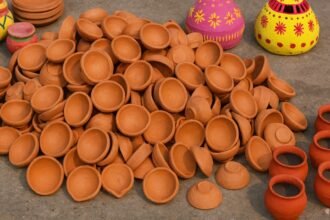In India, Navratri is more than just a festival; it is a profound celebration of womanhood. The nine goddesses worshipped over nine nights are not merely divine manifestations of Durga but also serve as a deep philosophical mirror to the nine stages of a woman’s life. From the innocence of birth to the completeness of old age, each goddess embodies the inner strength, resilience, and spiritual essence that a woman unfolds at every stage of her journey.
Shailputri: Birth and Innocence
On the first day, we worship Shailputri, the daughter of the Himalayas. She represents the purity and limitless possibilities of childhood, a stage ruled by innocence and curiosity. Just as a tiny seed holds the promise of a mighty tree, Shailputri reflects the boundless potential of a young girl’s life.
Brahmacharini: Adolescence and Discipline
The second goddess, Brahmacharini, symbolizes adolescence a period of intense learning, self-discipline, and perseverance. Holding a rosary and a water pot, she embodies a student’s devotion to knowledge and inner strength, guiding a young woman through her formative years of self-discovery and goal-setting.
Chandraghanta: Marriage and Domestic Balance
Chandraghanta, worshipped on the third day, represents a woman’s role in her marital home. With a crescent moon on her forehead, she masterfully balances tenderness with courage. She symbolizes how a woman nurtures her family with love and, at the same time, protects her household with remarkable strength.
Kushmanda: Creation and Early Motherhood
The fourth goddess, Kushmanda, is revered as the creator of the universe. She symbolizes the stage of early womanhood and motherhood, where a woman’s creative and nurturing energies flourish. It is a time when she brings new life, ideas, and hope into the world, embodying the very essence of creation.
Skandamata: Motherhood in Full Bloom
On the fifth day, we revere Skandamata, the mother of Kartikeya. Depicted with her child in her lap, she embodies unconditional love, sacrifice, and boundless care. This stage signifies a woman’s complete immersion in motherhood, where selflessness and resilience define her existence.
Katyayani: The Courage of Midlife
The sixth goddess, Katyayani, was born to slay the demon Mahishasura. She represents the warrior spirit within every woman, a quality that emerges in midlife. This stage is often marked by professional challenges, family responsibilities, and the need to assert one’s dignity and rights in society. She symbolizes the courage and determination to fight for what is right.
Kalaratri: Facing Darkness and Struggles
On the seventh day, Kalaratri is worshipped. Fierce and fearless, she represents the phase of life where a woman confronts her deepest fears, personal losses, or societal challenges head-on. Just as she destroys ignorance and darkness, women at this stage embrace transformation and emerge with a renewed sense of inner strength.
Mahagauri: Maturity and Serenity
The eighth goddess, Mahagauri, dressed in white, reflects the calmness and wisdom of maturity. After years of struggles and experiences, this stage is about purification, self-reflection, and finding inner peace. A woman becomes a source of wisdom, guidance, and harmony for her family and community.
Siddhidatri: Old Age and Fulfillment
On the ninth day, Siddhidatri is worshipped as the granter of boons and ultimate wisdom. She symbolizes the final stage of life—old age—when a woman becomes a matriarch, a reservoir of knowledge and experience who guides the next generation with the wealth of her life’s journey.
Conclusion
Navratri, in this light, is more than just a spiritual observance; it is a philosophical tribute to the journey of womanhood. Each form of the goddess mirrors the unfolding path of a woman—from innocence to wisdom, from creation to completion. By honoring these nine forms, we pay homage to the timeless power, resilience, and spiritual depth of women.















